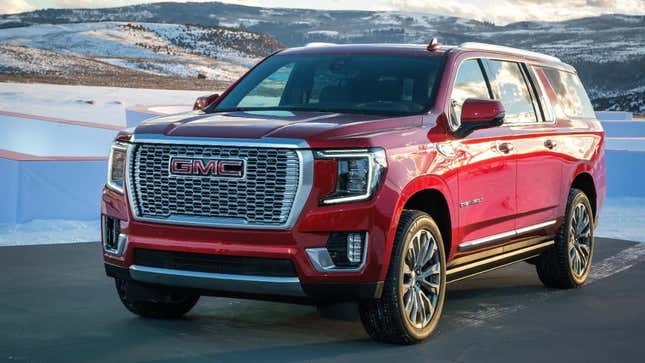
The new 2021 GMC Yukon reportedly has some surprising tricks up its sleeve, at least according to a talkative GM engineer at the crossover’s debut event earlier this week.
Last month, we already saw EV startup Rivian show off its so-called “Tank Turn,” where the electric hub motors at each wheel allow each side of the vehicle’s wheels to spin in different directions (on loose surfaces only, Rivian advises), essentially allowing the truck to spin in place.
Apparently the still-gas-powered 2021 Yukon may feature a similar capability. An engineer speaking to Motor Trend claimed the Yukon was capable of a so-called “Hurricane Turn,” and I’ll let them explain how they were told it works:
So, how do the GMC Yukon’s conventionally driven wheels help the vehicle spin? We weren’t able to extract many details from GMC on this front—the engineers were hoping to keep a lid on the feature until a later date, so we did our best to pepper them with questions at the ‘21 Yukon’s reveal event.
Here’s what we could surmise: “Hurricane Turn” functionality is engaged when the Yukon’s electronic brain detects that the driver intentionally has done the following: Deactivates stability control, cranked the steering wheel hard to either the left or the right, and floored the gas.
If the truck is on a low-friction surface, such as snow or gravel, the system jumps into action, manipulating the brakes, particularly on the side you’re steering toward (if you’re steering to the right, then it grabs the right brakes, and vice versa) to instigate a sort of donut move.
In this state, the GMC rotates around its front axle, like someone competing in one of those spin-around-a-baseball-bat-before-running competitions. Keep your foot on the throttle, and the GMC’s “Hurricane Turn” system will gradually tighten the donut spin radius—a technical term we just made up—until the Yukon is nearly spinning around its central axis, like the Rivian.
So where the Rivian uses innovative powertrain technology to pull off the effect, GM found a way to do it with brakes and steering.
Like Rivian, GMC insists on only doing the trick on loose surfaces, like gravel or dirt, because attempting the spins on pavement or concrete is probably too much friction and you may break something.
That’s also probably why GMC wanted to wait until later and not show everything off at the vehicle’s debut. Perhaps there’s some concern about reliability and liability if they go out and encourage everyone to do Walmart parking lot donuts right away.
Jalopnik reached out to GMC to confirm Motor Trend’s account, and here’s the response from a spokesperson:
This isn’t a feature we are actively promoting and did not demonstrate it at the reveal. One of our talented and enthusiastic engineers mentioned it to Motor Trend in passing. It wasn’t something we set out to do, just the result of very precise calibration work.
It also sounds like if you were to disable traction control, crank the wheel all the way to one side, and mash the gas pedal in just about any powerful vehicle, you could probably get it to spin just about in place anyway? I’m curious just how much engineering GMC actually had to do to make it elegant, but I don’t imagine it was much.
Hopefully, we see the move in action soon enough. I’m sure as shit attempting it if I ever get behind the wheel of a new Yukon.